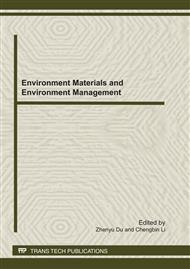[1]
WANG Li, ZHAO Bin, YUAN ZhongYong: Sci China Ser B-Chem, vol. 50 (2007), pp.63-69.
Google Scholar
[2]
Meng Zhang, Xiaodong Xu , Milin Zhang: Materials Letters, vol. 62 (2008), pp.385-388.
Google Scholar
[3]
Malandrino G, Finocchiaro S T, Nigro R L, et al. Chem Mater, vol. 16 (2004), pp.559-5561.
Google Scholar
[4]
Vijaya Kumar R, Elgamiel R, Diamant Y. Langmuir: vol. 17 ( 2001), pp.1406-1410.
Google Scholar
[5]
Jia D Zh, Yu J Q, Xia X. Science bulletin: vol. 43 (1998), pp.172-174.
Google Scholar
[6]
Gao X P, Bao J L, Pan G L, et al. J Phys Chem B, vol. 108 (2004), pp.5547-5551.
Google Scholar
[7]
Wang W Z, Zhan Y J, Wang G H: Chem Commun, 2001, pp.727-728.
Google Scholar
[8]
Malandrino G, Finocchiaro S T, Nigro R L, et al. Chem Mater, vol. 16 (2004), pp.5559-5561.
Google Scholar
[9]
Carnes C L, Stipp J, Klabunde K J, et al. Langmuir, vol. 18 (2002), pp.1352-1359.
Google Scholar
[10]
Welton T. Chem. Rev., Vol. 99(1999), p.2071-(2083).
Google Scholar
[11]
Antonietti M, Kuang D B, Smarsly B, et al. Angew. Chem. Lnt. Ed, Vol. 43(2004), pp.4988-4992.
Google Scholar
[12]
Wang L, Zhao B, Chang L, et al. Sci China Ser B-Chem, Vol. 50(2007), pp.224-229.
Google Scholar
[13]
Wang J, Cao J M, Fang B Q, et al. Matter. Lett., Vol. 59(2005), pp.1405-1408.
Google Scholar
[14]
J.G. Huddleston, H.D. Willauer, R.P. Swatloski: Chem. Commun. vol. 16 (1998), p.1765.
Google Scholar
[15]
Y. Zhou, M. Antonietti, J. Am. Chem. Soc. vol. 125 (2003), p.14960.
Google Scholar
[16]
L. Cammarata, S.G. Kazarian, P.A. Salter: Phys. Chem. Chem. Phys. 3 (2001) 5192.
Google Scholar
[17]
Y.Y. Xu, D.R. Chen, X.L. Jiao, J. Phys. Chem., B, vol. 109 (2005), p.13561.
Google Scholar
[18]
Kruk M, Jaroniec M. Chem Mater, vol. 13 (2001), pp.3169-3183.
Google Scholar
[19]
Ma J H, Yang H Q, Song, Y Z, et al. Science in China Series E: Technological Sciences, Vol. 52(2009), pp.1264-1272.
Google Scholar
[20]
Lyu Y Y, Yi S H, Shon J K, et al. J Am Chem Soc, vol. 126 (2004), p.2310-2311.
Google Scholar


